Picture a garden that isn’t just about the flowers. Instead, imagine a garden teeming with vibrant colors, rich fragrances, soothing melodies, engaging textures, and even delicious tastes. Luckily, such a place no longer has to exist in your imagination! Sensory gardens are designed to offer an immersive experience for our senses, healing us from our impoverished sensory landscapes while inspiring creativity, memory, and more. Read on to learn more about sensory gardens, their many benefits, and how to design one!
What is the Purpose of a Sensory Garden?
Unlike other landscapes, sensory gardens are specially designed to engage all five of your senses, going beyond the visual beauty of flowers to create an experience for our eyes, ears, noses, fingers, and even tongues. Sensory gardens awaken parts of ourselves that have long fallen dormant amongst our unengaging urban landscapes of roadways and parking lots, often without our realizing it. As a result, they heal, revive, and inspire forgotten facets of ourselves that have fallen into disuse.
What are Some Sensory Garden Benefits?
Our senses have co-evolved in an intimate relationship with the amazing complexity and diversity of old-growth spaces. We’ve spent most of our evolutionary history walking through wildflower meadows and ancient forests, surrounded by birds, insects, plants, animals, sky, and earth. Today, however, many of our modern landscapes are missing this multidimensional collage of life that once engaged us. Recovering this bond with nature through a sensory garden has many benefits, including:
- Therapeutic Healing: Ever find yourself overwhelmed by the bustle and noise of city life? A sensory garden restores our inner balance by immersing us in a soothing yet engaging space, reducing anxiety, promoting relaxation, and benefiting mental well-being in the process.
- Mindfulness: Often, it can seem like our inner monologues are stuck on repeat, constantly worrying about the future and the past without ever taking the time to enjoy the present. When our senses are engaged, they ground us in the present moment, allowing us to turn our brains off for a brief moment and simply be.
- Creative Inspiration: Being in a state of present relaxation allows us to tap into our creativity, sense of play, and inner joy more easily. Our nervous system becomes replenished through contact with a rich ecosystem, and insights, ideas, and epiphanies become more frequent and possible.
- Sensory Exploration: Most jobs require thinking, often in a cold office setting or other indoor areas, meaning we rarely have time to enjoy the more sensuous aspects of life. Among the melodies of birdsong and the fragrance of herbs, you can reconnect with the simple natural pleasures on offer from the living world.
How to Design a Sensory Garden in Chicago
Before you can reap its many benefits, your sensory garden first needs an engaging design. The key is to incorporate elements for each of the five senses:
- Sight: Incorporate a variety of colorful flowers, textured foliage, and interesting focal points. Play around with contrasting and complementary elements, and choose a selection of plants that will keep your garden colorful year-round. For extra visual interest, attract butterflies and other beneficial insects to your garden by adopting insect-friendly practices and habitats.

- Smell: Introduce fragrant plants like lavender, jasmine, roses, lilac, honeysuckle, pine, bee balm, echinacea, and herbs. Position them along pathways or near seating areas to immerse you and your guests in their delightful aromas.
- Touch: Incorporate plants with different textures, such as soft grasses, fuzzy leaves, and rough barks, and include features like water fountains, wind chimes, and textured sculptures to provide tactile stimulation. Different hardscapes also create unique tactile experiences, like mulch pathways, brick patios, and rock gardens.
- Sound: Bring music to your garden with flowing water features, leaves rustling in the wind, and wind chimes. You can also encourage more birdsong by creating bird habitats in your yard. These gentle sounds promote relaxation and create a tranquil ambiance.
- Taste: Integrate edible plants like herbs, berries, or vegetables into your garden, and encourage your visitors to engage their taste buds by sampling your fresh produce.
The end result is a multidimensional sensory treat, a natural orchestra alive with scents, colors, tastes, and music that reconnects us with nature and all its benefits.
Giving Your Sensory Garden a Local Illinois Feel
Designing a sensory garden gives you a great opportunity to dive into the sensory experience of our local Illinois plants and embrace the unique yet uncannily familiar smells, looks, and tastes of our native species. By using local plants and materials in your sensory garden, you can explore and preserve your local ecosystem while showcasing its unique character and charm to your neighbors, a real win-win scenario that benefits everyone!
For more information on sensory gardens and their benefits or to simply browse our extensive selection of plants, feel free to visit our garden centers in Bloomingdale and Carpentersville!
Platt Hill Nursery is Chicago’s premier garden center and nursery.




